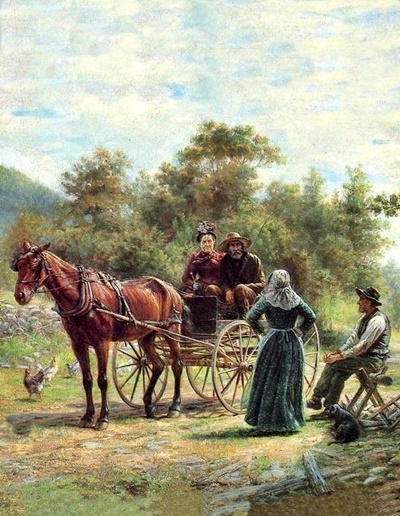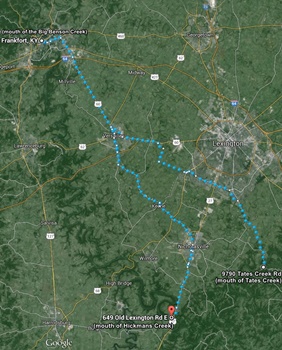| John Bushong and Jenette Young Part One
|















|
|
The Frontiersman and the Lady
John Bushong
and
Jenette Young
Part One
By Rick Bushong
September 10, 2015
|
Visualize John and Jennet on a buggy ride maybe visiting their son George Bushong and his wife, Lydia. Illustration, with liberties, from a painting by Edward Lamson, 1841-1919.
|
|
|
John Bushong
 | | |
John Bushong | | Jenette Young Summers |
September 17, 1760 | | about 1760 |
Married April 6 1785
Their Children
- George Bushong
- Nancy Bushong (Young)
- Sarah Bushong (Mitchel)
- James Bushong
- John Bushong, (Jr.)
|

The Old Swedes Church, in Wilmington, Delaware, where John was baptized in 1760. It is now a National Heritage Site.
| |
Over 250 years ago, on Wednesday, September 17, 1760, John Bushong was born, in Wilmington, New Castle County, Delaware.1 He was the fourth child of Johann Anthony Andrew Bushong, (Sr.), but the first child with his second wife, Catherine (maiden name not known).2 His father, known as Andrew had been born in Schmalenberg, Súdwestpfalz, Rhineland-Palatinate, Germany. He was German-Swiss by heritage, with lineage back to a Protestant refugee whose line began in Boltigen, Switzerland.3: 4 It is not known, but seems probable, with Andrew's strong German-Swiss heritage, that his new wife, Catherine came from a similar German or Swiss-German heritage too. Andrew had been living in Wilmington for some six years, before John's birth having landed there in 1754, on the ship Recovery. But Andrew had originally immigrated in 1732 to Philadelphia, Pennsylvania and had lived in Lancaster County. It had been, sometime in 1752 or 1753, when following the death of his first wife, Marie Catrina, (maiden name not known) and his first child John Henry and daughter Maria Julianna, that Andrew sold some land and with the money traveled back to Europe and back, only returning to Delaware.3
|
With winter approaching on Sunday, Dec 7, 1760, Andrew and Catherine brought their 11 week old son to the Old Swedes Church, also in Wilmington. Probably during the day's services, with as many as 250 other Lutherans in attendance. Andrew carried his son down the aisle, and across the cold brick floors that had been there since 1698.5 Andrew walked up to Reverend Andrew Borell, standing at the pulpit, waiting to receive the child. With a splash of water, Reverend Borell, baptized the young baby, John Bushong, and wrote in his records, "John, the son of Andrew Busheon and Cathrina."6
| |
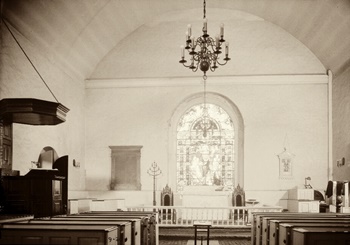
Virtually unchanged for over 250 years, the church's interior looked much like this when Andrew and Catherine brought John to be baptized in December, 1760. With the exception, of the stained glass windows, made by Louis C. Tiffany's company, which was added in the 1880s.
|
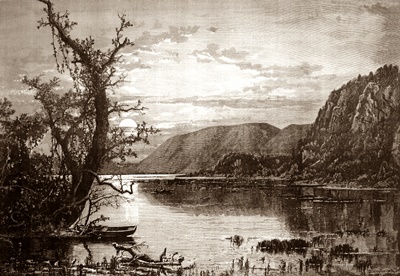
The Shenandoah River by Moonlight by J.D. Woodward, 1873. The Cub Run was on the South Fork of the Shenandoah River.
|
|
Sometime before 1761, with the third and final French and Indian War winding down, John's parents, left the relative safety of Delaware and took John, some 120 miles west to Frederick, Frederick County, Maryland. They might have lived there a year or so, and in December 1761, John's brother, Jacob was born. Then on April. 25, 1762 the family attended young Jacob's baptism which was in a church, of Lutheran faith, in Frederick.8 They did not stay very long in the area and within a few years, (before 1766) the family, consisting of Andrew and Catherine, along with Andrew Jr. who was a son from Andrew's first marriage, and the two young boys, John and Jacob, had moved to Augusta County, Virginia. There, John's father and his uncle Henry Bushong, had obtained land warrants on a stream called Cub Run, where they made their homes.9 The Cub Run, is described as a left hand branch of the Shenandoah River. John along with his younger brother, Jacob and older brother, Andrew, began their new lives in Virginia, and in 1768, when he was eight years old, John's family became larger with the addition of a new brother, George. Then, in 1771, Henry, and inevitably another brother Valentine, whose date of birth is unknown.9 It is not sure how many years John and the family remained in Virginia, but by May of 1780, they had left the gentle Cub Run stream. They traveled into the newly opened and short lived Transylvania Territory, on the western frontier, part of which included the future state of Tennessee.
|
|
|
John followed the rugged trails to Nashville, Tennessee, along with the family and his father who had been enticed with the opportunity of new land, in the Transylvanian Territories. When John was 19 years old, Andrew signed the Cumberland Compact there, May of 1780 and the signers of the Compact were virtually all land owners in the area.10: 11 How long the family lived Tennessee is uncertain. Even at the time their land, probably part of the larger tract of land, from the Cherokee Nation, had already been declared illegal. It had also further incited the Shawnee Indians who were British allies. Less than a year later, the family headed to the north east, to what would become the state of Kentucky. In order to get to Kentucky, the family's only route, was on the Wilderness Trail, recently opened by Daniel Boone. His sixty plus year old father, and the family are thought to have ended up near Lexington, in Fayette County. However, by April 21, 1781, John had joined Kentucky's Lincoln County Militia to fight the Indians. Both he and with his brother Jacob served as privates, in Brigadier General George Rogers Clark's, expeditions against the Shawnee Nation. They were in Captain John Martin's Company of Militia ordered from Lincoln County under the Command of Colonel Stephen Trigg, They were discharged May 27 1781, having served 37 days.12
Living in Kentucky and now coming of age, John begins to be noted in the civic records of Kentucky and later Ohio. At first, John, who could read and write, spelled his name "Bishong," but somewhere along the way, he changed to the conventional spelling, of his father and his brothers, (who also changed later). It might be worth mentioning that up until this point, aside from his birth, baptism, and service in the Kentucky Militia, John's whereabouts is only implied, as logically he would be with his parents. November 20, 1781, six months after being discharged, John submitted affidavits to court that he could not afford to purchase land at the state price, and thus eligible for a land grant because of his military service.13
|
|
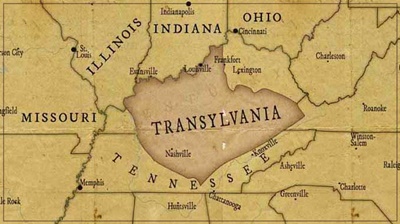
A map showing the quasi-legal Transylvania Territory, that was disbanded and redrawn into legal territories.
|
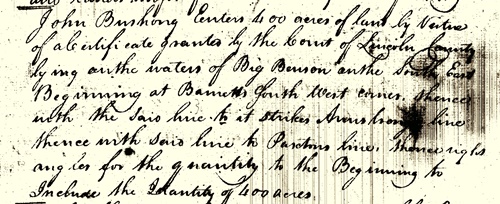
The recorded deed for John's 400 acres on Big Benson Creek in Fayette County, Kentucky.
|
|
John worked as a surveyor for a while and Jan. 27, 1783, he was part of the crew who surveyed for a Nimrod Dunken, 325 acres (indexed 335 acres) on waters of Hinkstons Fork, Fayette County, Kentucky.14 Trekking the land, surveying, probably helped John to find the right piece of land and possibly as will be seen, finding the right woman, motivated him to register it. Because on March 18, 1784, his four hundred acres, on the Big Benson Creek, in Fayette County, Kentucky Territory (later Franklin County), was duly registered. It would take John a year or so, to make the home, where he and a wife would live and all their children would be born. Then the spring came, and the 24 year old John, was married. On April 6, 1785 in Lincoln County, Kentucky, "John Beshong" and his new father in-law, John Summers, signed a bond to the Governor of Virginia allowing the marriage of Mr. Summers' adopted daughter, "Jannet Summers" (Jenette Young-Summers), to John.15
|
|
|
It is not certain when Jenette Young was born, but it was likely between 1755 and 1761, in Augusta County, Virginia, probably in the Staunton area, She was the daughter of Patrick Young and Isabella Todd.16 But her father, Patrick tragically died when she was a young girl, leaving mother Isabella, with the three daughters and a son. Isabella remarried John Summers, also in Augusta County. It should be mentioned that the date of Isabella and John's marriage is not known, and to this, a listing in Chronicles of Scotch-Irish Settlement in Virginia. Records of Augusta Co, VA 1745 - 1800, Volume 1 on page 342, has caused much confusion.
Chapter titled: County Court Judgments. Aug 1801 (M-Z) (page 327)
Page heading: November 1766 (A)
"Summers vs. Campbell, -John Summers and Issabella, his wife, late Isabella Young, complain of James Campbell and Richard Woods. Bond dated 23d June 1761."
From this many genealogists have concluded that Isabella and John Summers were married before the date noted on the bond, June 23 1761. But this is incorrect, because Patrick Young's estate was not yet settled and it would not be, until November 18, 1762. For Isabella to take a husband before then, would add considerable complication to the settlement of the estate, and Isabella would have been listed, Isabella Summers in the estate papers. What has caused so much confusion was the notation "Issabella, his wife, late Isabella Young".
|
|
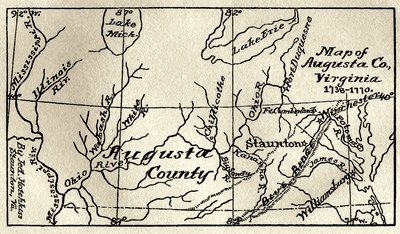
A map showing Stanton, Virginia and also future home, Chillicothe, Ohio. By J. A. Waddle
|
A look at the full book, shows that this entry for November 1766 in the chapter, titled "County Court Judgments," was obviously made by a clerk. The clerk just made a brief note about the case, and the entry is in no way the original complaint. So in this case, though the bond originated in 1761, the complaint or suit was not finally resolved until 1766. This is mirrored in the other notations, that the full complaints, suits or cases, are not listed, and that the bonds originated much earlier than the cases were settled. Between the complaint and the settlement, Isabella had indeed married John Summers and was rightfully called Isabella Summers, as the clerk noted.17
|
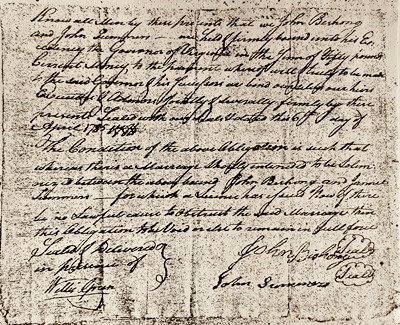
"Know all men by these presents. That we John Beshong and John Summers are held and firmly bound unto his Excellency the Governor of Virginia..." John and Jenette's 1785 marriage bond.
|
|
Since the date that Patrick Young's estate was settled is November 18. 1762, which is the same date, John Summers became the Young children's guardian, it is a likely guess that John and Isabella were married close to that date, if not the same day.18 It should be mentioned that of the two defendants in the case, Richard Woods was also involved with Patrick Young's estate as an appraiser, and possibly other duties, James Campbell was a signer on Patrick Young's will.19
Jenette Young with her siblings, and Isabella, were now part of John Summers, family, and spent the next few years in Augusta County. In 1773, the family moved, some 207 miles to Washington County, Virginia, in the western portion of the state.20 Around 1779-1780 John Summers and the family migrated to Kentucky. Eventually, John Summers lived in Fayette County, Mercer County, Clark County, Green County and ultimately Barren County.20 Somewhere in those moves, probably in Fayette County, Jenette met John Bushong and they were married in 1785, in Lincoln County, Kentucky, and they began their lives together. But when Jenette married she gave her last name as Summers, not Young. This is understandable, since John Summers had acted as her father and guardian for many years. It is altogether possible she did not remember her original name, and it is also probable she had never heard of her father's and his family's heritage. As such she more than likely did not know she was descended from royalty and entitled to bear the title of "Lady."
|
Lady Jenette Young of Clan Lamont
Jenette Young, also called Jannet, and Jenny, is the daughter of the son of the son of the son of Sir John Lamont. Her great great great grandfather was indeed royalty in Clan Lamont (pronounced Lahm-it) of Scotland,.  Listen The Lamont line is descended from "Anrothan O'Neill," an Irish prince from the O'Neill dynasty, who came to Scotland. It is his descendants who founded the ruling clans of Scotland, Clan MacLachlan, Clan MacNeil of Barra, Clan Ewen of Otter, and Clan Lamont.21 The much storied Lamont Clan's fortunes began to fall, when they sided with Clan MacDougall, against Robert the Bruce, in the first War of Scottish Independence, 1296-1328 resulting in the loss of much of their territory to the Clan Campbell, their rivals. But perhaps what was the death knell for the Clan came in 1646, when the Lamonts, were forced to surrender to the Campbells. The Campbells had been given the hospitality of the Lamonts, in Castle Toward, but murdered the Lamonts in their beds, causing the surrender of the remaining Lamonts. The terms of the surrender agreed by the Campbells promised to spare the remaining Lamonts, but the Campbells treacherously imprisoned them at Dunoon Castle and shortly after, executed them in what became known as the Dunoon Massacre. Eventually, in 1661, the ringleader of the Dunoon Massacre, Sir Colin Campbell, was brought to justice and stood trial on charges of High Treason. Being found guilty, he was beheaded. The Lamonts were installed back in power, but having been virtually incapacitated in the massacre, never actually gained control. Listen The Lamont line is descended from "Anrothan O'Neill," an Irish prince from the O'Neill dynasty, who came to Scotland. It is his descendants who founded the ruling clans of Scotland, Clan MacLachlan, Clan MacNeil of Barra, Clan Ewen of Otter, and Clan Lamont.21 The much storied Lamont Clan's fortunes began to fall, when they sided with Clan MacDougall, against Robert the Bruce, in the first War of Scottish Independence, 1296-1328 resulting in the loss of much of their territory to the Clan Campbell, their rivals. But perhaps what was the death knell for the Clan came in 1646, when the Lamonts, were forced to surrender to the Campbells. The Campbells had been given the hospitality of the Lamonts, in Castle Toward, but murdered the Lamonts in their beds, causing the surrender of the remaining Lamonts. The terms of the surrender agreed by the Campbells promised to spare the remaining Lamonts, but the Campbells treacherously imprisoned them at Dunoon Castle and shortly after, executed them in what became known as the Dunoon Massacre. Eventually, in 1661, the ringleader of the Dunoon Massacre, Sir Colin Campbell, was brought to justice and stood trial on charges of High Treason. Being found guilty, he was beheaded. The Lamonts were installed back in power, but having been virtually incapacitated in the massacre, never actually gained control.
|

The Lamont Coat of Arms.
|
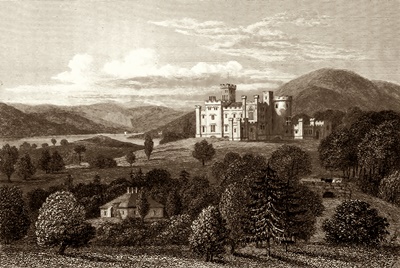
Castle Toward, in Scotland, built years after Toward Castle was destroyed. It is currently for sale and the grounds include the original castle ruins.
|
There were survivors of the 1646 Campbell treachery and they fled for their lives. One who survived was Sir John Lamont's wife, Mary Young Lamont, who escaped with her four sons 39 miles across the sea from Scotland to the town of Larne in County Antrim, Northern Ireland. They were never to return to Scotland and in order to further protect her sons from the Campbells, their surname was changed. John, the oldest, took the name Sitlington, which was the name of a small stream on their Scotland estates. The two middle sons took the names White and Green. The youngest son, Andrew, took his mother's maiden name of Young and he is Jenette's great great grandfather.21 As such, Jenette is a direct descendant of Scottish and Irish royalty and entitled, until she married John, to bear the title of "Lady" and the Lamont coat of arms. Incidentally, the lines of Irish Royalty were carefully recorded, and can be followed back as far as written history can possibly go, including Egyptian Pharaohs and Judean Kings and further into mythology.
|
|
John and Jenette in Kentucky |
To The Honorable The Speaker and Gentlemen of the House of Delagates (petition #63)
The Petition of sundry of the Inhabitants on the North side of the River in the district of Kentucky Humbly begs leave to Represent; that they experience many dificulties in
carrying their Tobacco to the Warehouses already establish'd by Law at Jacks Creek on the South side of the River Kentucky and at the mouth of Hickmans Creek, owing to the danger of discending the cliffs, the badness of the Roads and the Risque of crossing the River. That there is a Comodious and conveniant place for an Inspection below the mouth of Tate Creek on the Lands of Michael (Bedinger) and nearly where the Main Road leads by an easy, and safe discent down the Hill to the said River of Kentucky.
We your Petitioners therefore pray, that you would be pleased in consideration of the Premisses to pass a Law, establishing a Warehouse on the Lands of the said Michl Bedinger
about three fourths of a mile below the mouth of the aforesaid Tates Creek, under such Regulations and Restrictions, as you, in your Wisdom may deem fit and Proper.
Endorsement on back of petition: 2nd. Novr. 1789
(signatures include John Bishong25}
|
|
A map showing the original route John would have taken and the proposed route. Map ©Google, all rights reserved.
|
The mouth of Hickmans Creek, now in Jessamine County is one of central Kentucky's more historic places. As a natural shallow fording across the Kentucky River it was passable by foot or wagon for most of the year. The Wilderness Road additionally used the Hickman Ford and its path branched there. By 1785 it was the site for one of the earliest ferries. 26 The other warehouse site, was at the mouth of Tate Creek, now known as Valley View Ferry Landing, in Madison County, Kentucky, 27 It is a just downstream from the Mouth of Tates Creek, also on the Kentucky River. The ferry here, began operation in 1785 also, and currently is the oldest continuously operated business in Kentucky. It is now the only remaining ferry on the Kentucky River.27
|
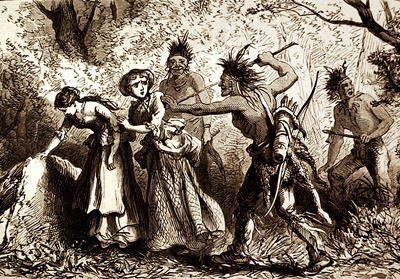
Titled Two Kentucky girls captured by Indians. The Shawnee were fierce and at war with the Kentucky settlers for many years.
|
|
Studying a map, the original site and the proposed sites in the petition, are both around 40 miles from the mouth of the Big Benson Creek, at Frankfort, and somewhere along the creek, John and Jenette had their land. So either way, to haul tobacco from the mouth of Big Benson Creek, to the warehouse could have been about 40 miles, a round trip of 80 miles, which on a horse drawn wagon on such trails, could easily take a week. This would leave Jenette alone for periods, yet with the ongoing threat of Indian attacks, their home must have been close to other family, who could offer protection, or possibly Jenette left her home and stayed with family. Never the less, Indians were always close by and were still very much at war with the settlers. Just between the years 1776 and 1790, some 1500 settler were killed by the Indians, along with others who were captured or injured. The conflict with the Indians would last until 1795.28 With John alone for extended periods driving his wagon over the lonely and primitive roads, and Jenette left alone much of the time, it was without a doubt a dangerous time for both of them.
From the 1789 petition, concerning the transport of tobacco, it is certain, John was involved in tobacco, but it does not necessarily mean he was farming it, at least commercially. He could have been involved in freighting other farmer's crops and tobacco was one of the biggest. He would still be very concerned with the roads. Sometime the same year, 1789 or possibly 1790, John's father died, in Fayette County. Later, the Fayette County tithable's list (often called the 1790 Census), was made February 27, 1790, it again counted John Bishong, among the taxpayers and landowners.29 Sometime that same year, John and Jenette, had a daughter, Nancy. Then July 4, 1791, John Bushong's younger brother, Henry and Jenette's half sister, Isabelle Summers, were married, in Lincoln County, (later Monroe County).30 This further linked the Bushong and Young-Summers families together. In 1793 they had another daughter, Sarah "Sally." However a little over three years later, John, obviously looking for new opportunities, has traveled north. Leaving a wife pregnant, with their last child and his namesake, John ventures into the Northwest Territory. But after starting a keel boating business, he will soon bring the family and their new home would become Ohio...
|
This Article is Copyright ©2015, ©2018 by Rick Bushong and Commercial Use is Prohibited.
Non-commercial use is permitted if copyright information is included.
Continue to Part Two: The First Bushongs in Ohio click here
|
Bushong United is Copyright ©2018-2023 by Rick
Bushong any Commercial Use is Prohibited.
Non-commercial use is allowed with permission or if
copyright is included.
Photographs, unless otherwise noted, are in the commons, and are free use. No bandwidth theft allowed.
To Direct Search the Bushong United Family Tree
click here
|



